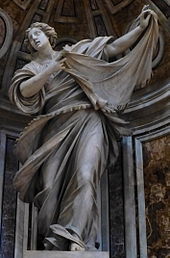Francesco Mochi
Francesco Mochi (also Francesco Mocchi , born July 29, 1580 in Montevarchi near Arezzo in the Grand Duchy of Tuscany , † February 6, 1654 in Rome ) was an Italian sculptor and medalist of the early Baroque .
Life
Trained as a sculptor in Florence under the influence of the work of the sculptor Giovanni da Bologna (Giambologna), he moved to Rome shortly before 1600 (around 1600 many commissions were to be expected in connection with the "Holy Year").
In 1603 he received his first major commission through the mediation of Mario Farnese for the cathedral of Orvieto , an annunciation angel who was influenced by Tuscan Mannerism and which will be followed three years later by a Mary of the Annunciation ( Annunziata ). It is the debut works that establish his fame beyond Orvieto. In the following years he was called in for the major furnishing projects during the pontificate of Paul V. Borghese (Cappella Borghese in Santa Maria Maggiore in Rome). In 1612 the city of Piacenza called him to realize a large equestrian statue project on the Piazza Comunale : equestrian statues made of bronze in honor of the great general of the Farnese family, Alessandro , and the then ruling Duke of Parma and Piacenza, Ranuccio I. The completion The work, which is very expensive and labor-intensive, with all the details of the base reliefs, accompanying putti bearing coats of arms, etc., goes on until 1629.
After returning to Rome, Mochi immediately received the order for the marble statue of Saint Veronica in one of the domed pillars of Saint Peter in Rome because of the reputation he had acquired as a sculptor of monumental sculptures . He appears there in connection with the sculptors Gianlorenzo Bernini and François Duquesnoy, also in the eyes of the client and the public as one of the recognized, outstanding sculptors of his time. During this time, which he spends almost exclusively on the conception and implementation of his main work, the statue of Veronica, which he interpreted in this way, only minor works such as busts of the family of Pope Urban VIII and other clerics and private persons as well as small bronzes and smaller marble works were created. Only after completing the large-scale work in St. Peter's Church (the statue of Veronica is around five meters high) does he again take on orders for monumental marble statues such as the individual figures of St. Peter and St. Paul for the Abbey Church of San Paolo Fuori le Mura . However, these works were not accepted by the clients and were later transferred to the Porta del Popolo . With this failure in the 1640s, the decline of the sculptor Mochi began. Although his fame even spread abroad through the statue of St. Veronica - Cardinal Richelieu wants to move him to Paris to found an art academy - in Rome, where he wants to stay, his status and reputation as a sculptor are in doubt . He is involved in the Accademia di San Luca , becomes its president for a short time, but acts primarily as an opponent of Bernini and rallies the group of opponents of Bernini around him. When he died in 1654, he left an order from the Falconieri family ( like him from Tuscany ) for the national church of the Florentines San Giovanni dei Fiorentini in Rome.
plant
His work includes large, often larger than life, marble statues, the two monumental equestrian statues in Piacenza, a limited number of marble busts, although new assignments are possible here given the large number of unidentified busts in Rome and outside, individual small bronzes and smaller marble works. Francesco Mochi, with virtuoso and seminal, also technically brilliant beginnings in Orvieto, the glamorous equestrian statues in Piacenza with their effect on the baroque riders from Paris to Berlin, St. Veronica in St. Peter, is one of the great sculptors of the early Baroque . Because of his idiosyncratic conception of the moving robe and his direct references to antiquity as the measure of all things, he was respected in his time, but not perceived as progressive. It had almost completely disappeared from the memory of art history in the 18th and 19th centuries and has only recently been the subject of scientific treatises.
literature
- Maria Giovanna Sarti: Mochi, Francesco. In: Mario Caravale (ed.): Dizionario Biografico degli Italiani (DBI). Volume 75: Miranda – Montano. Istituto della Enciclopedia Italiana, Rome 2011.
- Rudolf Wittkower : Mochi, Francesco . In: Hans Vollmer (Hrsg.): General lexicon of fine artists from antiquity to the present . Founded by Ulrich Thieme and Felix Becker . tape 24 : Mandere – Möhl . EA Seemann, Leipzig 1930, p. 601-602 .
Web links
Individual evidence
- ^ L. Forrer: Mocchi, Francesco . In: Biographical Dictionary of Medallists . tape IV . Spink & Son Ltd, London 1909, p. 100 ( Textarchiv - Internet Archive ).
- ↑ Meinolf Siemer: Francesco Mochi (1580–1654). Contributions to a monograph. Wuerzburg 1989.
| personal data | |
|---|---|
| SURNAME | Mochi, Francesco |
| ALTERNATIVE NAMES | Mocchi, Francesco |
| BRIEF DESCRIPTION | Italian sculptor |
| DATE OF BIRTH | July 29, 1580 |
| PLACE OF BIRTH | Montevarchi |
| DATE OF DEATH | February 6, 1654 |
| Place of death | Rome |

